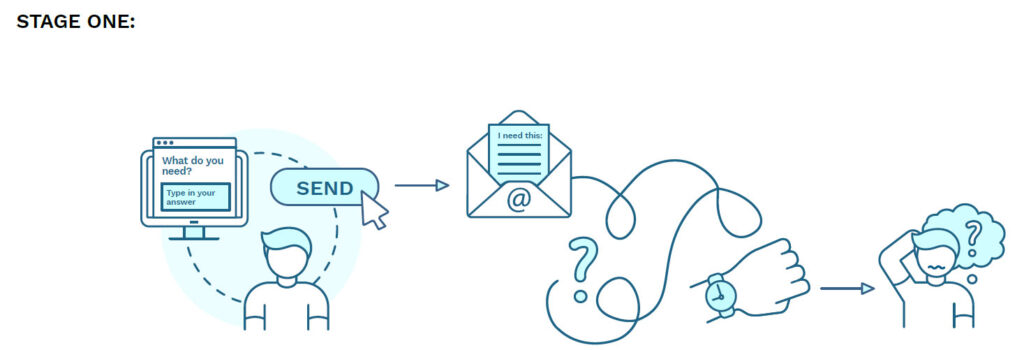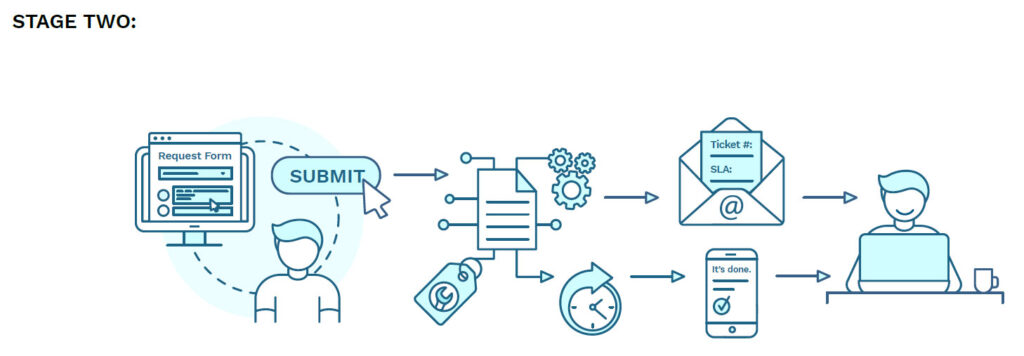How to Move a Business Process from Automation Stage One to Stage Two
Automating manual business processes is a multi-stage initiative. Here’s how to take the first step toward process management, improvement, and automation.
Transforming a manual business process to one that is structured and managed can cut the cost in half and reduce typical completion time from weeks to days. Those are just a couple of the benefits of moving processes from stage one to stage two (as detailed in our last post) of the Kinetic Automation Maturity Model (KAMMsm).
The requirements for a stage one process are simple. Strictly speaking, the only technology that’s really required is an email inbox for request intake. And then the organization needs to communicate to its employees (or customers, suppliers, constituents, channel partners…whomever will be submitting requests), “Have questions? Email us here.” That’s one approach.
It’s very common that organizations will create a web page or portal with a form that enables a requester to type in unstructured text, and then automatically sends the input to a defined email inbox.
 Companies may have fairly impressive systems for handling that workflow. They may have an interface built in Remedy, ServiceNow, or another ITSM platform. But if all the system is doing is collecting unstructured text and forwarding it, that process is still stuck at stage one.
Companies may have fairly impressive systems for handling that workflow. They may have an interface built in Remedy, ServiceNow, or another ITSM platform. But if all the system is doing is collecting unstructured text and forwarding it, that process is still stuck at stage one.
To move from stage one to stage two processes, an organization needs three elements:
- Process intelligence, which helps determine which processes are the best candidates for automation.
- Process definition, so that the organization isn’t trying to automate poorly defined or inefficiently designed process workflows.
- Client-side logic, which assures that fulfillers will receive valid data enabling them to fulfill requests or resolve issues.
Process intelligence: A common approach is for an organization to analyze its last 100, 1,000, or some number of unstructured requests to identify the most common problems: invoiced the wrong amount, shipped the wrong product, delivered the wrong quantity, whatever those problems may be.
The next step is to determine what information is needed in order to resolve each of those issues: order number, shipping number, expected items or quantity, actual items or quantity delivered, etc.. With this information, the company can move from a form asking for unstructured text to one with a drop-down list of issues the user can select from, and fields for the information required for each request type.
Process definition: Processes must be defined and documented before any type of automation can be applied. Which department and/or individuals should be assigned to each type of request? What information is needed? What is the process for resolving the problem or fulfilling the request? What information needs to be communicated back to the user, and when? Who (if anyone) needs to approve the request? What are thresholds for approval (e.g., any request over $100 needs to be approved by finance)?
Client-side logic: The final requirement is to have the right technology in place—a system that enables the organization to build customizable or configurable front-end forms. Client-side logic checks for the validity of the input to each form field. For example, phone numbers need to have 10 digits. Order numbers always start with an X. If the input doesn’t adhere to the rules, the system will display an error message and ask the user to re-enter the data for that field.
Field-level validation is a key requirement, so that when the form data is submitted to the fulfilling individual or department, it contains valid, quality information.

Once those three elements are in place, the best candidate processes can be transitioned to stage two. This is usually based on volume. However, even low-volume processes are candidates for stage two if they involve legal or compliance matters.
A Stage One to Stage Two Example: DoD Form 2875
As noted above, stage one processes often involve simple web-based forms and/or an email inbox. But many still involve paper forms. The requester fills out a paper form, submits it to a designated individual or drop box, and then…has no visibility as to what happens next or the status of the request. Those are typical characteristics of stage one processes.
One paper form that will be familiar to anyone who works or does business with the U.S. Department of Defense (DoD) is Form 2875. This form is used by contractors, military personnel, civilian employees, or other qualified individuals to request access to specific DoD systems. The form can be downloaded online, and once completed, is typically faxed, mailed, or physically delivered to the appropriate location.
Since a separate Form 2875 must be submitted by each individual working on a project, a contractor may have to submit dozens or even hundreds of forms for a single program. There’s no confirmation of receipt once a form is submitted, and getting a response can take anywhere from a couple of days to several weeks.
The individual responsible for approving the access may not want to approve the project. The form may get misrouted. There may be a data entry mistake on the form; for example, the account code or specified domain doesn’t exist.
Any number of issues may cause approval to be delayed or rejected, requiring the requester to complete and submit a new form—beginning the whole process over again. These paper forms don’t have any validation or provide any visibility.
At stage two, a requester would fill out the Form 2872 online. Field-level validation enabled by client-side logic would prevent any errors or erroneous information from being submitted. The requester would get a confirmation of receipt, and then have visibility into the status of their access request. There may still be some sort of delay in approval, but at least the requester would know exactly where and with whom their request is “stuck.”
Summing Up
Transforming a business process from manual to fully automated isn’t accomplished in a single move. The first step is to transition from stage one (a manual process) to stage two (a process that is structured and managed).
The KAMM framework outlines a six-stage process to take a process from manual to fully automated. But even taking the first step can significantly reduce the time and cost of fulfillment while increasing accuracy and providing some level of visibility.
Going from stage one to stage two requires three elements:
- Process intelligence to help select the best processes to automate first.
- Process definition which describes how requests are handled and fulfilled.
- Client-side logic to validate data as is entered into an online form.
One common example of a stage one to stage two transition is to convert a static document-based process (paper or PDF) to one using active form logic for validation, routing, approval, and status tracking.
In our next post, we’ll look at the next stages of automation maturity and help you evaluate whether your organization is moving towards desired goals and flows.



